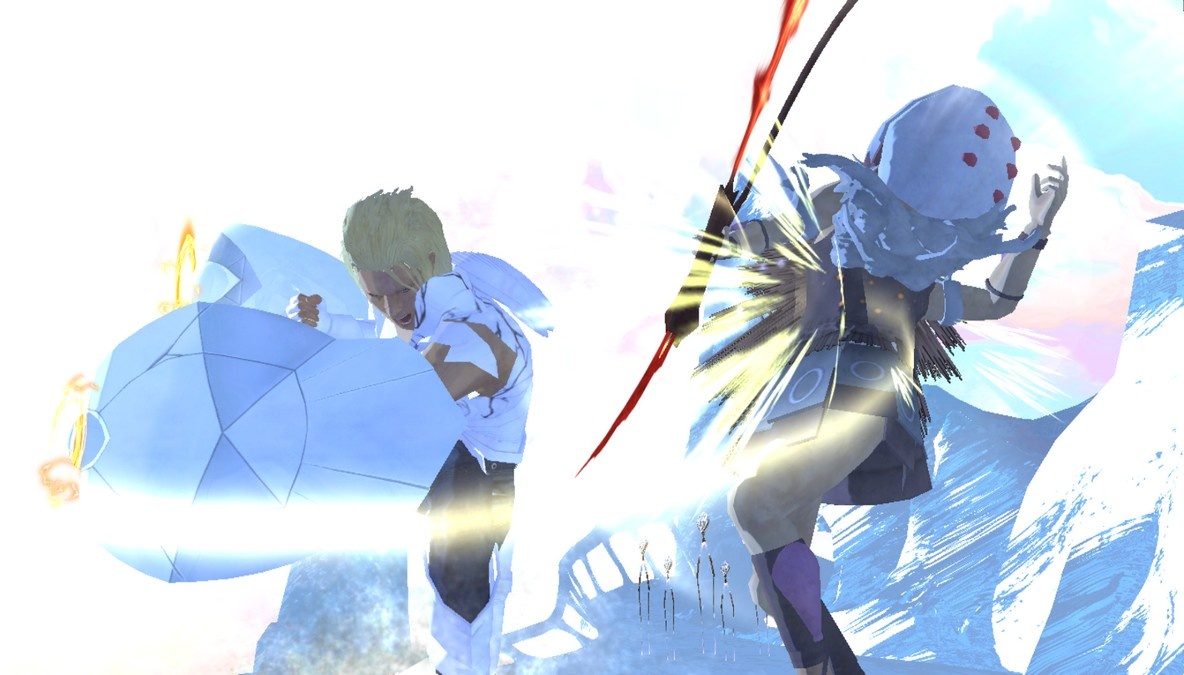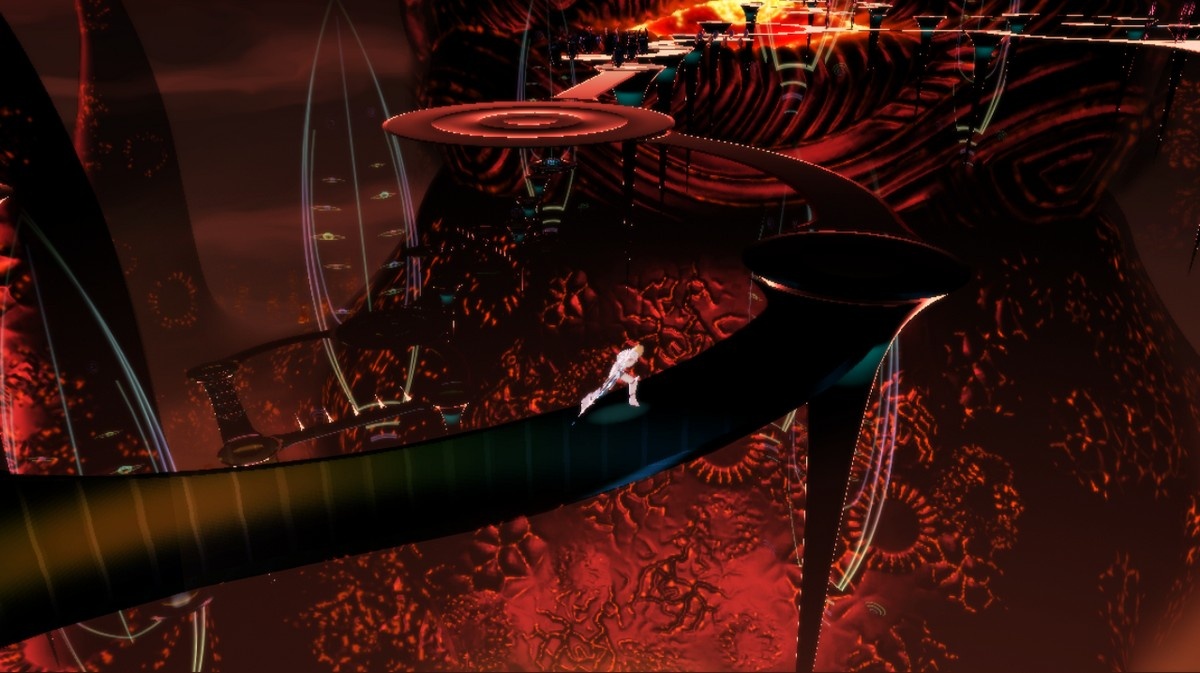El Shaddai: Ascension of the Metatron Updated Preview
We tinkered around with the first few chapters of the Japanese version of the full game.

When Ignition Entertainment was planning on creating a loose video game adaptation of the Book of Enoch, we didn't think the result would be the oddity known as El Shaddai: Ascension of the Metatron. GameSpot Asia delved through the first few chapters of the PlayStation 3 version of the full product and experienced a game that really took advantage of its abstract setting. Keep in mind that this preview may have minor spoilers.
The gist of the story is that main character Enoch has been sent down to Earth to find the Tower of Babel and confront the seven Watchers who brought down sacred knowledge of God to the humans without His permission. From what we've played so far, the game consists of a mix of 3D action, where you navigate a linear path while beating up group upon group of enemies (with a boss fight against the Watchers tossed in for good measure), and 2D platforming segments, where our jumping skills were put to the test.
Controlling Enoch during the action segments felt natural. His attacks and guards came out responsively; pressing the square button consecutively unleashed combos, while holding it down made Enoch perform a heavy attack. Guard breaks and perfect guards required a bit more finesse. For the former, pressing the square button and then pressing it again after half a second made us break an enemy's block, leaving him open for further assaulting. For the latter, pressing the R1 button as the enemy's attack hit parried the blow, which left us room to counterattack. While we did use these techniques sparingly, we knew that further chapters down the line would require us to improve our game, especially since replaying the game lets you gain ranks based on how well and fast you fight through them.

Enoch can steal three types of weapons from his foes when they're stunned: the arch, the veil, and the gale. The arch is a standard sword-type melee weapon, while the veil is a shield that unleashes slow but damaging blows. The stylish-looking gale acts as a ranged weapon, and Enoch can pick apart enemies from afar with the gale's floating triangle projectiles. The gale's damage output, even while charged, isn't comparable to the other two weapons, so using it up close isn't the wisest choice since enemies wielding gales and arches can't be knocked down while in their heavy attack animations. The three weapons balance each other out with their triangle relationship: the arch is strong against the veil wielders, the veil is strong against the gale bearers, and the gale is strong against arch users. Keep in mind that weapons can degrade and deal less damage upon further use, which means that you have to purify them by pressing the L1 button. Enoch is vulnerable while doing this, so you have to pay attention to do it when far away from threats.
These weapons also bestow Enoch with special movement abilities. When he's equipped with the gale, holding R1 and pressing the X button while pressing the left analog stick in any direction makes him do a quick dash that is handy not only for getting away from an enemy, but also for traversing the game's 2D stages. The arch's special ability is a quick forward hop that can take enemies by surprise, while the gale's skill lets Enoch short-dash forward while blocking. Personally, we abused the gale's special movement simply because it allowed Enoch to outmaneuver against overwhelming odds.
As a side note, disarming foes proved to be useful not just to switch out weapons to accommodate the combat scenario, but also as a means to leave foes powerless. As we performed simple melee combos with the arch on a gale-wielding giant to a point where it was stunned, we made short work of it after using its armaments against it. Enoch can use and carry only one weapon at a time, though, so you'll need to think a little before aimlessly stealing; we found that out the hard way as we struggled against two veil-equipped giants while stuck with the gale. When in said pickle, we were fortunate enough to use the overboost power unlocked during a major boss battle. This power-up allowed Enoch to be enveloped in a cool flame effect which boosted his attack power and regenerated his armor.

Should the untimely knockout of Enoch occur (the game's enemies were tricky to deal with), we could revive Enoch just before his eyelids closed by mashing the face buttons together with L1 and R1. The more times we kicked the bucket, the more times we were required to button-tap. We felt that this was a great addition that helped keep the flow of the game smooth without the need to head to the restart screen and stare at the loading screen.
While we had plenty to say about how Enoch enforced his physical version of the word of God, the obvious highlight of El Shaddai was the graphics and presentation. El Shaddai's environments and art style are definitely nothing gamers have ever seen before. From the second chapter's vast black and red corridor with circular platforms and a giant sphere with an eye overlooking in the background, to the third chapter's lovely mix of whites and grays coupled with a 2D segment peppered with watercolor-esque clouds, to say that the game was a creative feast for the eyes is a huge understatement. We haven't even gotten to the weirdness of the fourth chapter, where the tube-shaped race called the Nephilim were the stars of the acid-trip-inspired stage. The Nephilim acted as obstacles, using branches, seesaws, hula hoops, and beach balls in different ways to hinder Enoch's path to reach the white-void lair of one of the Watchers named Sariel. On another note, Lucifer acted not only as Enoch's guide, but also as a save point throughout the journey. When we came across him in-game, he was usually on his cell phone talking casually with God.

While El Shaddai seemed unabashed at being a linear action game, and a simple one at that, its aesthetics and abstract visuals were its main draw. We suspect that future chapters of the game will be even more esoteric than the ones we played, though that would work to the game's advantage. After all, games do need some sort of hook to be noticed, and the developers at Ignition Entertainment seem to have taken this to heart via the game's visual style and biblical setting. As it stands, we felt immersed in the world and scenarios of El Shaddai and look forward to seeing how bizarre the rest of the game becomes. While the Japanese version of the game is out now, the English version is slated for a July release.
Got a news tip or want to contact us directly? Email news@gamespot.com
Join the conversation